How has the Galaxy Z Flip series evolved?
A brief history of evolution
The Samsung Galaxy Z Flip is a line of smartphones that debuted in 2020 and permanently changed the market for foldable devices. A lot has changed from the first generation to the latest Galaxy Z Flip 7 – from the size of the external screen, through the durability of the construction, to features based on artificial intelligence.
Galaxy Z Flip (2020) – the beginning of the foldable era
- External screen: only 1.06 inches, displaying only the time, notifications, and basic information.
- Main screen: 6.7″, 60 Hz, no adaptive refresh rate.
- Durability: no IP certification, which meant high sensitivity to dust and water.
- Processor: Snapdragon 855+, 8 GB RAM.
- This was a pioneering model – interesting, but with many compromises.
Galaxy Z Flip 3 (2021) – the first real breakthrough
- External screen: increased to 1.9″ – finally, it was convenient to check notifications.
- Main screen: 6.7″ Dynamic AMOLED 2X with 120 Hz refresh rate.
- Durability: introduced IPX8 (water resistance, but not dust).
- Processor: Snapdragon 888.
- Flip 3 is the first model to reach the mainstream.
Galaxy Z Flip 4 (2022) – refined design
- Slimmer hinge and better battery (3700 mAh).
- Improved camera optimization.
- Still a small external screen (1.9″).
Galaxy Z Flip 5 (2023) – the end of the “small window”
- External screen: a huge leap to 3.4 inches, called Flex Window – finally, it was possible to use apps, take selfies with the main camera, and use FlexCam mode without compromises.
- A hinge that allows for a “flat” closure – the end of the visible gap.
- Snapdragon 8 Gen 2 processor, better performance and energy efficiency.
Galaxy Z Flip 6 (2024) – a step towards perfection
- External screen: still 3.4 inches, but with better brightness and features.
- Main screen: Dynamic AMOLED 2X with adaptive refresh rate of 1–120 Hz.
- Processor: Snapdragon 8 Gen 3 – top performance on Android.
- Durability: IPX8 – still no dust protection.
- New features: AI expansion in the camera (ProVisual Engine), better night photo optimization.
- Flip 6 was very refined, but still did not have a “full” external screen or features like DeX.
Galaxy Z Flip 7 (2025) – a revolution in everyday use
- External screen: up to 4.1 inches, 120 Hz, brightness of 2600 nits – full coverage of the flap, app support without opening the phone.
- Main screen: larger (6.9″), brightness of 2600 nits.
- Processor: Exynos 2500 (3 nm) – optimized for AI and energy efficiency.
- Durability: IP48 – finally protection against dust as well.
- New features: Samsung DeX in the Flip series, One UI 8 with Galaxy AI, support for updates for 7 years.
- Flip 7 FE: a cheaper version with an external screen like in Flip 6 and a weaker Exynos 2400 processor.
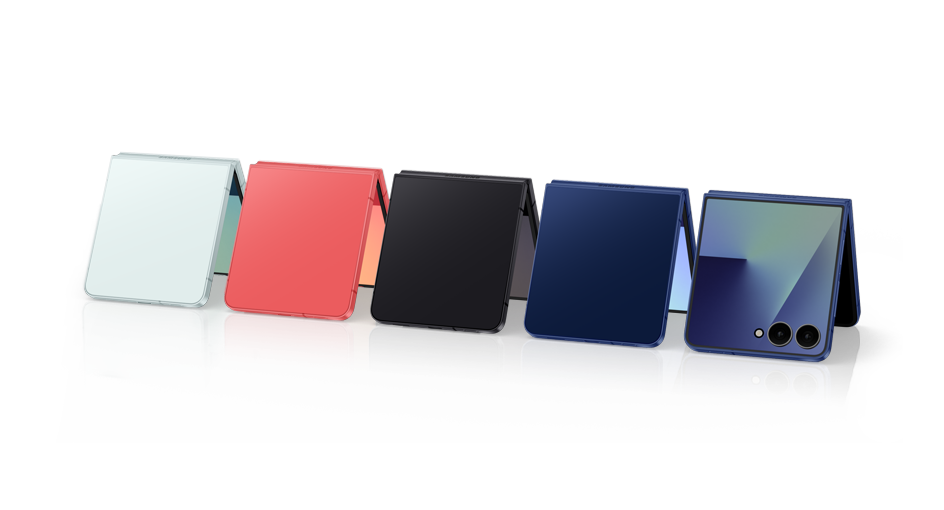
Galaxy Z Flip 7 vs Flip 6 screens – the biggest difference in the history of the series
External screen – bigger, faster, and brighter
Galaxy Z Flip 7 takes a huge step forward compared to Flip 6:
| Feature | Flip 7 | Flip 6 | Flip 7 FE |
|---|---|---|---|
| Size | 4.1” | 3.4” | 3.4” |
| Refresh rate | 120 Hz | 60 Hz | 60 Hz |
| Brightness | 2600 nits | 1600 nits | 2600 nits |
What does this mean in practice?
✔ Smoother scrolling (120 Hz),
✔ better readability in sunlight (2600 nits),
✔ support for multiple apps without opening the phone (navigation, Spotify, messaging apps).
Flip 7 FE retains the screen parameters of Flip 6 – this is one of the reasons for the lower price.
Main screen – minimal change, but important
- Flip 7: 6.9” Dynamic AMOLED 2X, 1–120 Hz
- Flip 6: 6.7”, the same technologies
A difference of 0.2 inches means more space for multitasking and split-screen mode.

Construction – slimmer and more durable Flip 7
- Thickness when unfolded: 6.5 mm (Flip 7) vs 6.9 mm (Flip 6)
- When folded: 13.7 mm vs 14.9 mm
- Durability: IP48 (Flip 7) vs IPX8 (Flip 6) – finally protection against dust
- Materials: Gorilla Glass Victus 2 + Armor Aluminum
The Armor FlexHinge hinge is even more durable and operates more smoothly than in previous generations.
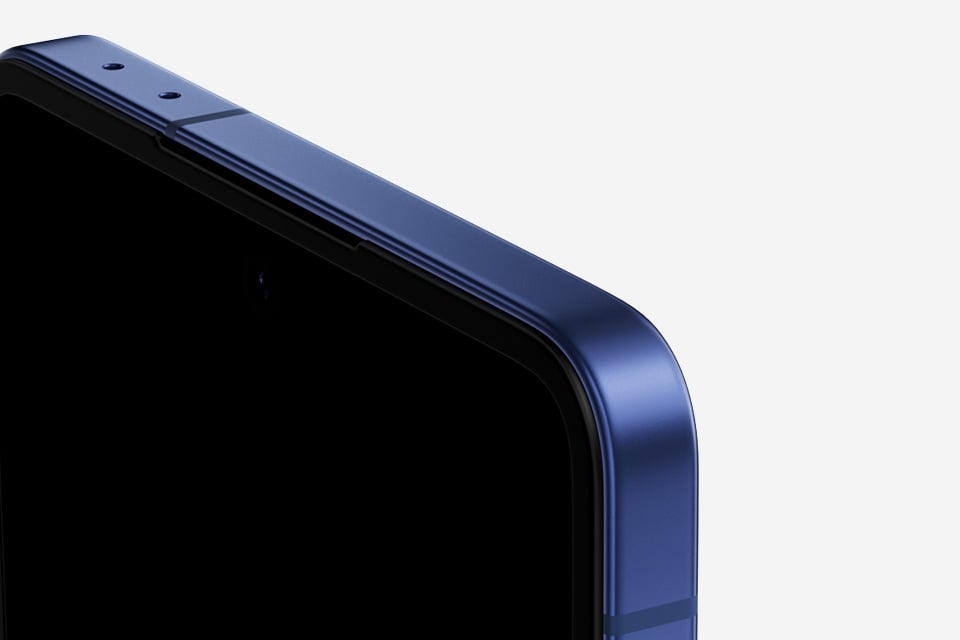
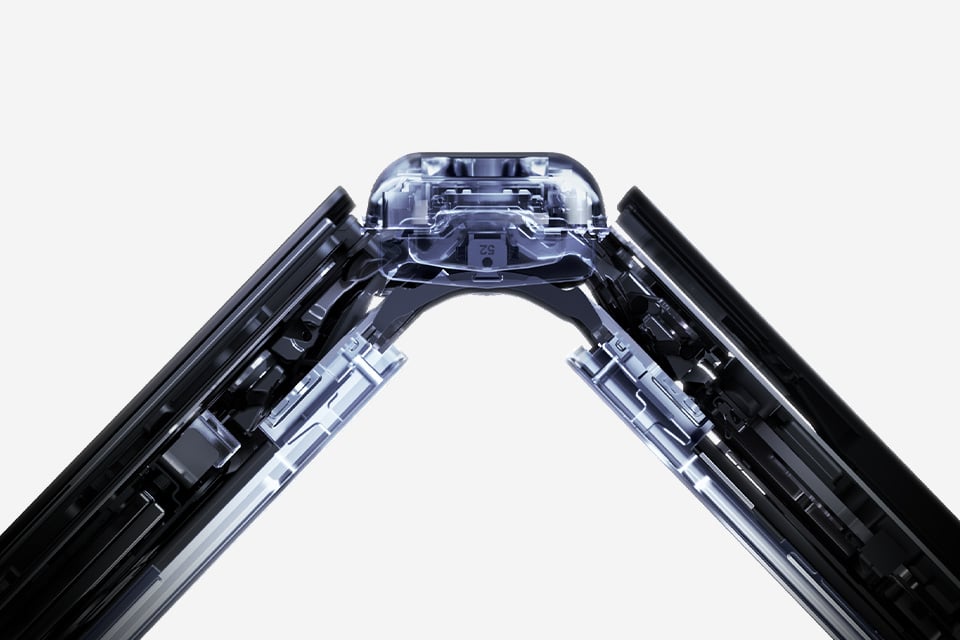
Performance – Exynos enters the game
The biggest change under the hood is the switch to Exynos processors:
- Flip 7: Exynos 2500 (3 nm) – energy efficiency and optimization for AI
- Flip 6: Snapdragon 8 Gen 3 – still top-notch, but without AI at the level of Exynos
- Flip 7 FE: Exynos 2400 (4 nm) – less powerful, but sufficient for everyday tasks
RAM:
- Flip 7 and Flip 6 – 12 GB
- Flip 7 FE – 8 GB
Battery and charging – more mAh, but still slow charging
Samsung has been faithful to its strategy of a moderate approach to charging speed for years. In the case of Galaxy Z Flip 7 the battery capacity has increased by 300 mAh compared to its predecessor, resulting in 4300 mAh. This is the largest battery in the history of the Flip series, and combined with a processor made using 3 nm technology, it translates to noticeably better runtime. In everyday use, this means even 10–15% longer battery life on a single charge compared to Flip 6.
Galaxy Z Flip 6 and Flip 7 FE offer a capacity of 4000 mAh, which still provides decent results, but under heavier load (e.g., using the external screen or recording video in Flex mode) the difference in favor of Flip 7 will be noticeable.
Charging – still a conservative approach
Despite the larger battery, Samsung did not opt for faster charging:
- Wired: 25 W – charging from 0 to 50% takes about 30 minutes.
- Wireless: 15 W – no improvement over the predecessor.
- Reverse charging: 4.5 W (e.g., for Galaxy Buds or Galaxy Watch).
Compared to the competition (Xiaomi, Oppo, or OnePlus with 67–100 W charging), this is an average result, but Samsung prioritizes battery safety and longevity.
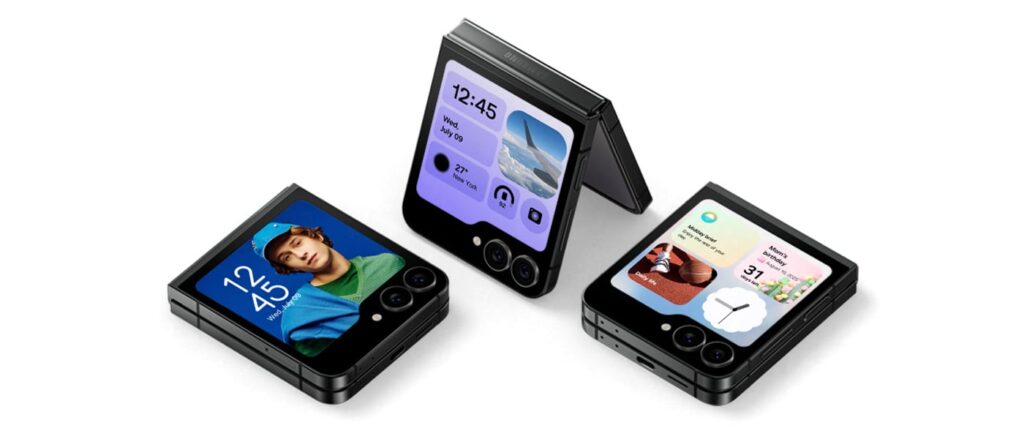
📷 Cameras – hardware unchanged, but AI makes a difference
In terms of hardware, there is no revolution – the camera set is identical to that of Flip 6:
- Main: 50 Mpix (f/1.8, OIS, 2x zoom)
- Ultra-wide: 12 Mpix (123°)
- Selfie: 10 Mpix
So why does Flip 7 take better photos? The answer lies in the software:
- ProVisual Engine: a new image processing engine that improves details and colors, especially in challenging lighting conditions.
- AI Zoom: automatic cropping without quality loss – perfect for selfies and vlogs.
- Better night mode: noise reduction and better sharpness thanks to AI.
Thanks to the larger external screen (4.1”), taking selfies with the main camera is even more convenient – you can frame photos while seeing a full high-resolution preview.
New features of Galaxy AI and One UI 8 – artificial intelligence at a new level
Samsung is heavily investing in AI in its new models, and Flip 7 is proof of how AI can simplify everyday life.
- Now Bar – a bar on the external screen with notifications, weather, music player, or app information.
- Now Brief – intelligent daily summaries: news, calendar, sports scores, content recommendations.
- Gemini Live – an advanced voice assistant that can perform complex tasks across different apps without touching the screen.
- AI Photo Editor – generative photo editing, automatic object removal, background enhancement.
- Real-time translations – useful while traveling and at work.
Importantly, Galaxy Z Flip 7 and Flip 7 FE will be updated until 2032 – that’s up to 7 years of support (system + security patches).

🖥️ Samsung DeX – Flip 7 turns into a computer
A novelty in the Flip series! For the first time, a foldable smartphone from Samsung supports Samsung DeX.
Just connect the phone to a monitor (wired or wirelessly) to use an interface resembling a computer desktop. You can:
- edit documents in Word or Excel,
- conduct video conferences on a large screen,
- use multiple apps in windowed mode.
Flip 6 and Flip 7 FE do not support DeX, so if you care about this feature, the choice is obvious.
📊 Comparison table: Galaxy Z Flip 7 vs Flip 6 vs Flip 7 FE
| Feature | Flip 7 | Flip 6 | Flip 7 FE |
|---|---|---|---|
| External screen | 4.1″, 120 Hz | 3.4″, 60 Hz | 3.4″, 60 Hz |
| Main screen | 6.9″, 120 Hz | 6.7″, 120 Hz | 6.7″, 120 Hz |
| Processor | Exynos 2500 (3 nm) | Snapdragon 8 Gen 3 | Exynos 2400 (4 nm) |
| RAM | 12 GB | 12 GB | 8 GB |
| Storage | 256/512 GB | 256/512 GB | 128/256 GB |
| Battery | 4300 mAh | 4000 mAh | 4000 mAh |
| Charging | 25 W / 15 W | 25 W / 15 W | 25 W / 15 W |
| Durability | IP48 | IPX8 | IPX8 |
| Samsung DeX | ✅ Yes | ❌ No | ❌ No |
Frequently Asked Questions
Is it worth upgrading from Flip 6 to Flip 7?
Yes, if you care about a larger external screen, full AI support and Samsung DeX. If you mainly use Flip 6 for photos and do not utilize the new interface, the change is not mandatory.
What is the difference between Flip 7 FE and Flip 7?
Flip 7 FE is a budget version with a smaller external screen (like in Flip 6), a weaker processor, and 8 GB of RAM. It still has Galaxy AI and One UI 8, but without DeX.
Does Flip 7 support Samsung DeX?
Yes – as the first Flip in history.
How long will Flip 7 be supported?
Until July 2032 – 7 years of system and security updates.
Summary – which Galaxy Z Flip to choose?
The choice between Galaxy Z Flip 7, Flip 6 and Flip 7 FE depends on your priorities and budget. All three models are exceptional clamshell smartphones, but they differ in details that can make a huge difference in everyday use.
Galaxy Z Flip 7 – the best choice for demanding users
Why is it worth buying?
- The largest and most functional external screen (4.1” 120 Hz) – allows you to handle multiple apps without opening the phone.
- New Exynos 2500 processor (3 nm) – better performance and energy efficiency, optimized for artificial intelligence.
- Samsung DeX – desktop mode, which is not available in previous Flips.
- Galaxy AI and One UI 8 – modern AI features that streamline daily tasks.
- Larger 4300 mAh battery – combined with an energy-efficient CPU means a realistically longer runtime.
- IP48 durability – finally protection against water and dust.
For whom?
Flip 7 is the choice for those who want the most refined foldable smartphone on the market, use multitasking, AI features, and appreciate compact design without compromises.
Galaxy Z Flip 6 – still great, but without a revolution
Is it worth buying Flip 6 in 2025?
Yes, if you find it at a good price. It still offers:
- Large external screen 3.4”, which allows for quick previews of notifications and selfies with the main camera.
- Snapdragon 8 Gen 3 processor – top performance, ideal for gaming and multimedia.
- Dynamic AMOLED 2X 120 Hz – the same main screen as in Flip 7.
What does Flip 6 lack?
- No Samsung DeX.
- Smaller battery (4000 mAh).
- No IP48 – still only IPX8 (no dust protection).
- No new Galaxy AI features in full version.
For whom?
For those who do not need the latest model, but want a great foldable at a lower price.
Galaxy Z Flip 7 FE – a cheaper foldable with AI
Why consider Flip 7 FE?
- Lower price than Flip 7, yet still the latest One UI 8 and Galaxy AI.
- Exynos 2400 processor (4 nm) – less powerful than in Flip 7, but sufficient for daily use.
- AI features, new design, and IPX8 durability (like in Flip 6).
Limitations?
- Smaller external screen (3.4” like in Flip 6).
- No Samsung DeX.
- Less RAM (8 GB) and less storage in the base version.
For whom?
For users who want a stylish Samsung foldable smartphone at a lower price, use AI, but do not need maximum performance.
Which one to choose?
- Do you have Flip 5 or older? Choose Flip 7 – the difference will be huge.
- Do you have Flip 6? Upgrade makes sense only if you care about a larger external screen, AI, and DeX.
- Want to save money? Flip 7 FE is a great compromise between modernity and price.
Remember to protect your foldable smartphone! Check out cases for Galaxy Z Flip 7 and cases for Galaxy Z Flip 7 FE, which will not only protect the device but also highlight its unique design.
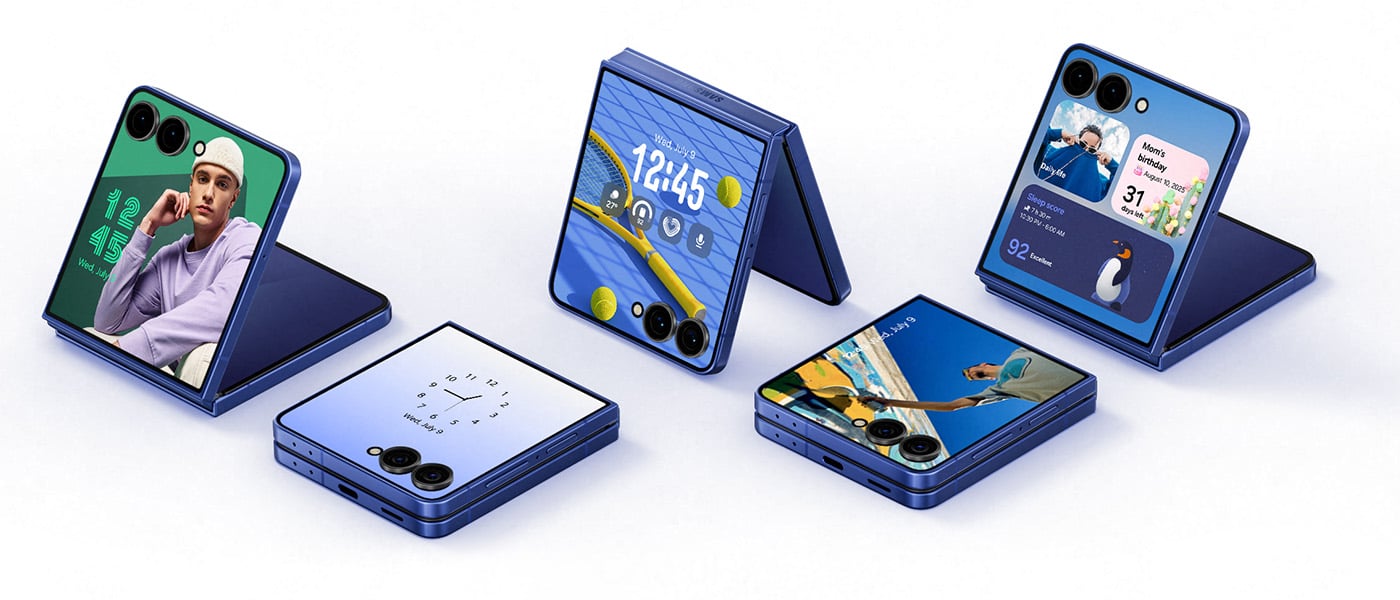
Leave a Reply